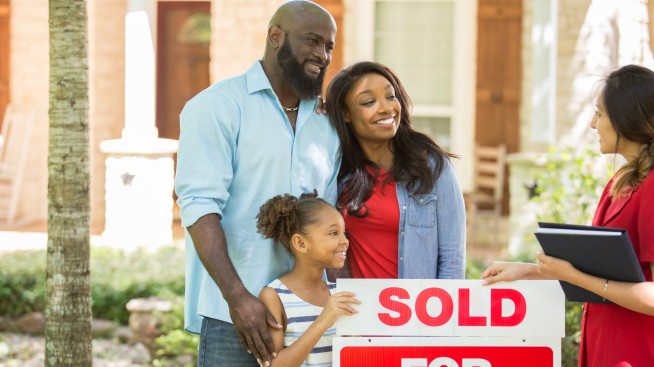What is a ranch-style house?

The simplistic, functional living, and ranch-style house is a classic fixture of American architecture. But where does the classic ranch-style come from, and what should potential buyers know about ranch-style homes? Let’s take a look.
Origins of the ranch-style house
Originating from the design language of Spanish colonial architecture, the ranch-house style can be traced to the 1920s American Southwest. The classic ranch house style borrows many of the low-slung roofs, stucco walls and somewhat rustic design elements found in the early ranches and haciendas of the time.
During the housing boom of the 1940s, designers began experimenting with incorporating some of these features on a more suburban scale. The style resonated with homebuyers and grew in popularity throughout the 1950s, promising homebuyers practical homes with spacious layouts, and builders with relatively affordable construction. It wasn’t long before the ranch style spread beyond the Southwest and grew to become one of the more distinctly American architectural styles.
Ranch-style houses: Key features
While there is great variation in the classic ranch-style home, there are a few characteristics that are considered staples of the style:
- Single story construction: One of the most distinctive traits of ranch-style house plans is their single-story construction. This fixture of the ranch style is said to give ranch homes a sense of sprawling space and better accessibility for residents.
- Open floor plans: Ranch-style homes tend to keep open floor plans, allowing for better flow between rooms and sometimes connecting the living, dining and kitchen areas in one expansive space.
- A horizontal layout: Their sprawling design stretches ranch homes out horizontally. This linear layout often means they have a wider façade, giving them a more pronounced presence on a property lot.
- Connects to the outdoors: Large windows, sliding glass doors and patios are common features of ranch-style houses. This tends to provide ample natural light and easy access to the outdoors that may be well-suited for nature lovers.
- No-frills design: The classic ranch-style house is known for its straightforward and functional design, emphasizing practicality over extravagance.
Variations of ranch-style houses
While the ranch house style is clear in its design language, numerous variations of the style have emerged over the decades. Here’s a quick rundown of some of the more common variations you might want to look out for if you’re interested in a ranch-style house yourself:
California ranch home
California ranches tend to sport higher square footage and place even greater emphasis on open floor plans. You’ll often find expansive windows and more outdoor living spaces, like courtyards and larger patios as well.
Storybook ranch home
As the name might suggest, the storybook ranch integrates some elements of near-fantasy into the design aesthetic. You might see features like ornate trim, diamond shaped windows or even the occasional turret.
Raised ranch home
A raised ranch, perhaps unsurprisingly, departs from your traditional ranch-style house by adding a second level to the house — oftentimes, with a basement and a split-level entrance. This provides some additional living space without breaking from the traditional ranch silhouette.
Suburban ranch home
A suburban ranch is usually more compact, with more modest backyards than the larger acreage that typically accompanies a classic ranch-style house.
Colonial ranch home
A colonial ranch blends the signature simplicity of a ranch with elements of the colonial aesthetic, such as brick facades, gabled roofs or shuttered windows.
Modern ranch home
The thing that separates a modern ranch from its more traditional counterparts is one part construction, and one part design. A modern ranch often integrates newer, generally more sustainable materials and energy-efficient planning alongside cleaner, crisper design aesthetics.
Split-level ranch home
A split-level ranch adds extra levels to the usual design, often with staggered floors that offer a clear separation of spaces. A common setup is to have living areas on one level and bedrooms on another.
Should you buy a ranch-style house?
The ranch-style house remains a popular architectural style for many reasons but it may not resonate with everyone. For those looking to buy a home, it might be helpful to consider some of the pros and cons that typically come with a ranch house.
Pros
- Accessibility: One of the standout features of ranch-style house plans is their single-story layout. Without stairs to traverse daily, ranch homes might be especially advantageous for seniors or families with young children.
- Ease of maintenance: Similarly, with your entire residence contained to one level, tasks like cleaning, maintenance and some home improvements might be easier to accomplish.
Cons
- Land requirement: The horizontal spread of ranch-style houses sometimes requires a larger lot size compared to typical multi-story homes.
- Heating and cooling demands: Wider floorplans could make heating and cooling less efficient in some ranch homes, potentially impacting energy costs depending on the home’s insulation and efficiency.
In summary
Ranch-style houses combine historical charm with practical design, offering spacious single-story living. Those looking for accessible, open layouts with some room to grow on their plot might be especially fond of a ranch-style house, especially since there are plenty of variations in the design to choose from.



